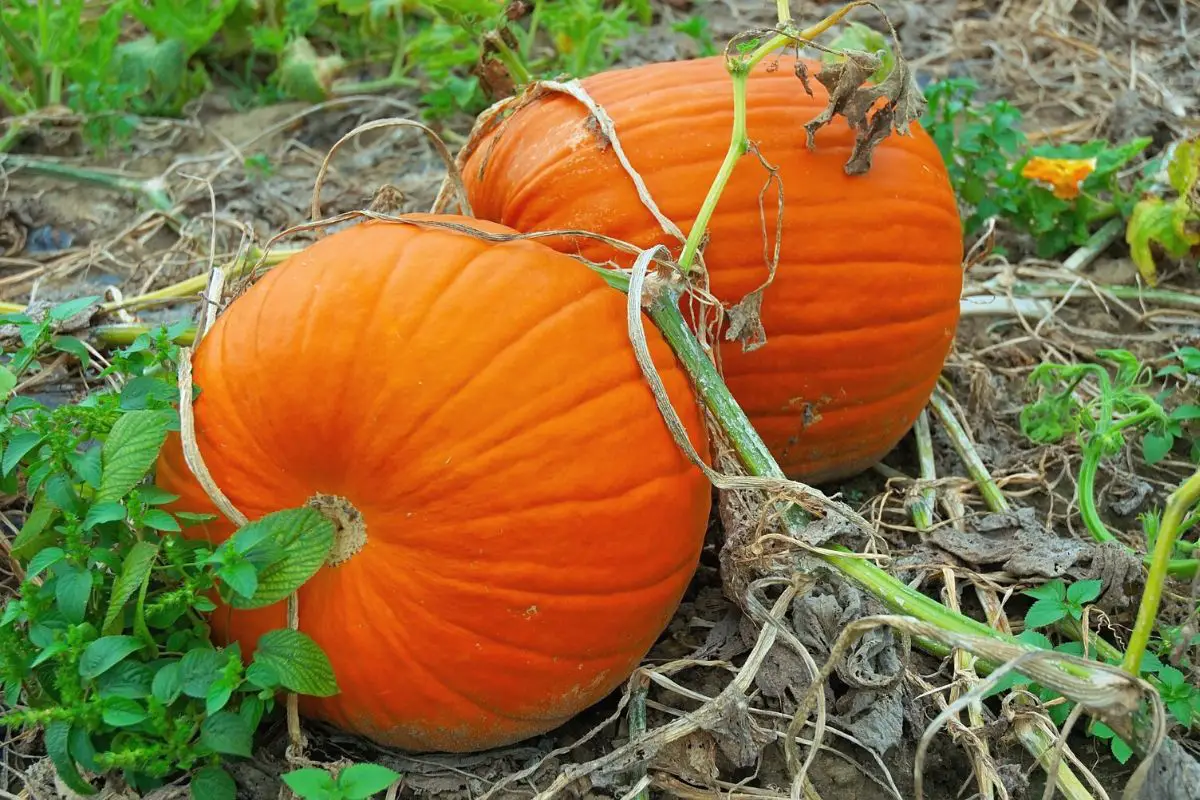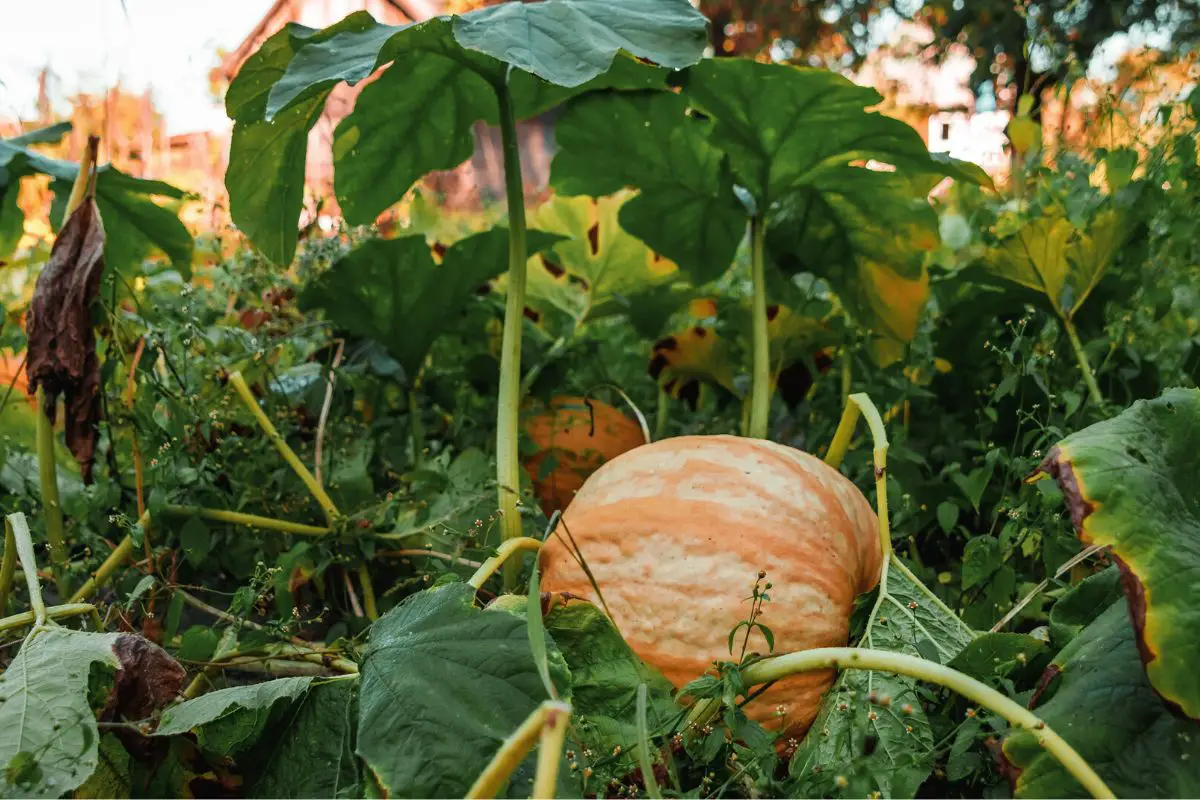It usually takes 3-4 months to grow a pumpkin, so it can be disappointing to find the fruits splitting on the vine before harvest. It’s important to understand the potential reasons for this issue to prevent it from happening.
Here are the reasons why pumpkins split on the vine:
- Genetics, evolution, and selective breeding
- Excess water
- Poor soil drainage
- Incorrect timing of fertilizer applications
- Incorrect pruning
- Delayed harvest
- Stem or vine stress
- Insufficient sunlight
- Too much sun and heat
This article will explore the common causes and share preventive strategies to ensure your pumpkins don’t split before harvest. I’ll also discuss what you can do with split pumpkins.
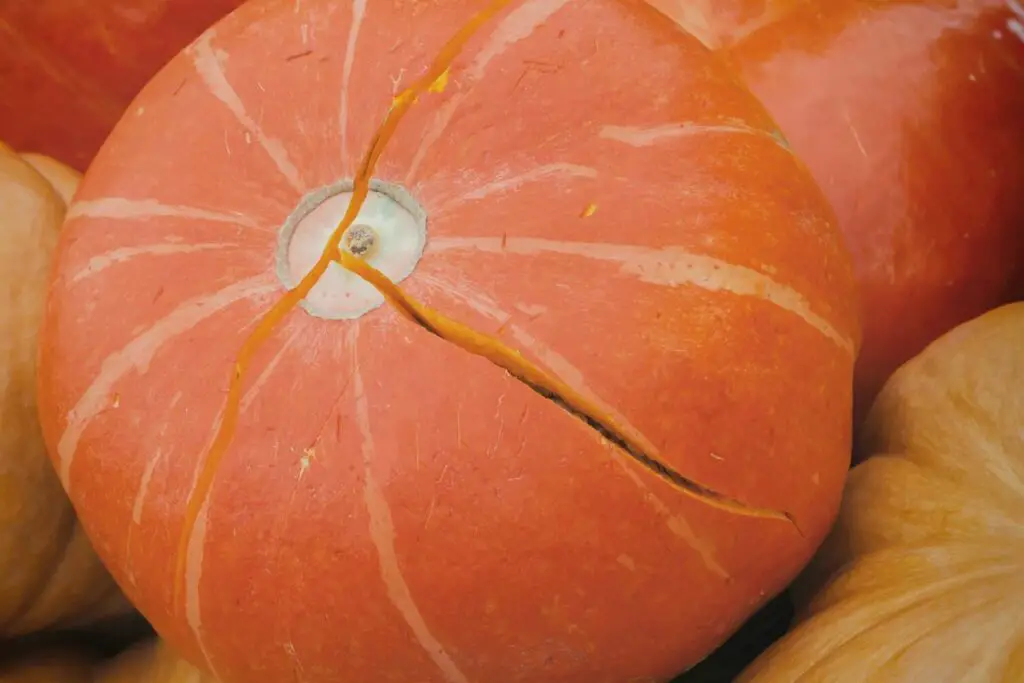
1. Genetics, Evolution, and Selective Breeding
The pumpkins that we know today are very different from their ancient relatives. The old pumpkins were bitter and depended on large animals (megafauna) like mastodons and mammoths to disperse their seeds.
Here’s the timeline for pumpkin evolution:
- Megafauna and seed dispersal: Large animals were tolerant to the bitter flavor of pumpkin flesh and were strong enough to break through the hard rind. This feeding behavior helped disperse seeds either through their feces or the leftover flesh.
- Megafauna extinction and natural cracking: Their extinction led to the loss of natural seed dispersers. However, pumpkins didn’t go extinct. As they remained on the vines and continued to grow, the expanding flesh created cracks along the rind, making it easier to disperse the seeds as the flesh dried out.
- Human intervention and cultivation: The cracking was nature’s way of preserving the plants before humans discovered and cultivated them. The intolerable bitterness of ancient pumpkins led humans to be selective toward the mild-tasting ones until the sweet-tasting varieties we have today were developed.
- Modern selective breeding: This process produced numerous types of pumpkins for various purposes: carving, decoration, and cooking. Some enthusiasts selectively breed giant pumpkins, such as the Dill’s Atlantic Giant. It is the parent of the pumpkin that currently holds the world record for the largest at 2,749 pounds (1,247 kg).
That said, many pumpkin varieties naturally crack or split open when left unharvested. The giant pumpkin varieties are more likely to split while still on the vine because of their rapid growth that the hardening rind can’t keep up with.
If you want to prevent your pumpkins from cracking, choose medium-sized varieties and steer clear of giant ones unless you’re joining competitions.
You can also refer to the other tips I’ll discuss below.
2. Irregular and Excess Water
Pumpkins are fast-growing and heavy feeders. They’re typically grown in the summer, so they require consistent moisture for optimum growth.
The plant also needs plenty of moisture as the fruits develop. However, you must slow down on watering when the rind hardens. Introducing excess moisture at this point will cause the flesh to expand and break through the hardened rind.
Heavy rains at the end of the summer or the beginning of the fall can also be bad for pumpkins that have an almost mature fruit. Excess water from the rain can lead to rapid uptake by the roots and the swelling of the fruits.
On the other hand, irregular watering that leaves the soil too dry before the next feeding will force the plant to absorb water rapidly the next time.
Proper watering and soil drainage are crucial to prevent these issues from harming the fruits. Established pumpkin plants will thrive with 1.5 inches (3.8 cm) of water every 7-10 days, including rainfall.
If you live in a hotter or drier climate, you can increase the volume to 2 inches (5 cm). You can feed the water all at once or split it into two feedings every 7-10 days to prevent rapid moisture loss from evaporation.
3. Poor Soil Drainage
As discussed, proper drainage is important to prevent overwatering issues that can lead to fruits splitting on the vine. Pumpkins require well-draining sandy soil to grow well.
If you have loamy or clayey soil that holds much moisture, I recommend planting your pumpkins in hills.
Here’s how:
- Dig hills about 6-12 inches (15-30 cm) deep and 2 feet (60 cm) wide.
- Mix two parts soil, one part compost, and one part sand to improve drainage and aeration.
- Place the mixture back into the hole until the pile becomes 6-12 inches (15-30 cm) tall and shaped like a volcano.
This planting method will reduce the risk of water-logging and prevent the roots from sitting on constantly wet soil. This also helps drain excess water quickly in case of heavy rains.
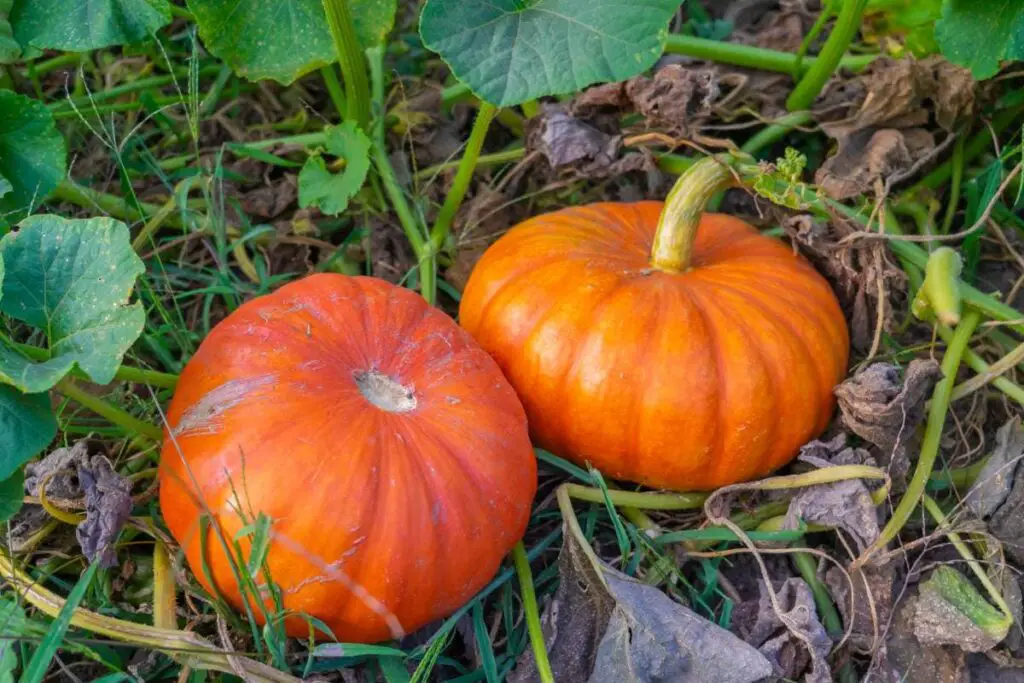
4. Incorrect Timing of Fertilizer Applications
Pumpkins need a balanced fertilizer early in the growing season. Once the flower buds appear, they will need low-nitrogen, high-phosphorus fertilizers.
Ideally, you should dilute a soluble 5-10-5 fertilizer to half the recommended strength and incorporate it into your watering routine. You can apply it once every two weeks as the fruits develop.
It can take 45-55 days for pumpkin fruits to mature after the flowers have been pollinated. The phosphorus supply will encourage the plant to develop bigger fruits.
Stop fertilizing as the rind hardens 2-4 weeks before harvest. Excess fertilizer at this point will lead to a growth spurt that will cause the rind to crack.
5. Incorrect Pruning
Competitive gardeners who grow giant pumpkins to join regional competitions typically remove other fruits from the vine to focus on the largest one. This will allow the fruit to develop faster and grow bigger.
However, pruning the other fruits too soon while fertilizing your plant regularly can cause the remaining fruit to enter a growth spurt. This can increase the risk of your pumpkins cracking or bursting before harvest time.
Remove the flowers and smaller fruits about four weeks before harvest because they likely won’t mature or grow big enough by harvest time.
This is also around the same time you can feed your plant its last dose of fertilizer. I recommend diluting it further to a quarter strength.
6. Delayed Harvest
As discussed, many pumpkins will eventually crack when left on the vine because the flesh will continue to grow even when the rind has already hardened.
Pests and diseases can also take over your plant and cause tears in the overmature fruits. Extended sun exposure, excess moisture, and secondary infections will lead to bigger tears on the rind and leave you with a mushy and sticky pumpkin.
To avoid wasting your produce, harvest it as soon as the rind hardens enough that you can’t make a dent in it with your fingernail.
7. Stem or Vine Stress
As pumpkin fruits enlarge, they can put a lot of stress on the stems or vines, causing them to split. The split may extend toward the fruit and tear through it. As the fruit gets bigger, the tear can become a larger crack that can break the fruit.
You can prevent stem stress by repositioning the fruit below the vines as it matures. If the vines have roots underneath them, you can cut them off from 2-3 nodes on each side. This will allow the vines to move upward freely as the fruit becomes larger.
8. Insufficient Sunlight
Pumpkins need full sun or at least 6 hours of direct sunlight daily to grow well. Plenty of sunlight is necessary to help the flowers and fruits develop optimally. Moreover, sunlight can help dry out the soil more quickly in case of water-logging.
Insufficient sunlight will keep the soil wet for extended periods and cause the fruits to absorb the excess moisture. The rind will not be able to keep up with the flesh’s growth, leading to tears on the surface.
To prevent this, grow the plant where it can receive enough sunlight. Avoid growing tall plants around your pumpkins that can shade them out.
9. Too Much Sun and Heat
Sunlight is also necessary to harden the rind as the fruit matures. These plants grow well in warm regions and can tolerate up to 95 °F (35 °C) in the summer.
However, too much sun and heat will lead to the following issues:
- Premature rind hardening will make it prone to cracks if the flesh continues to expand.
- The sun-exposed part of the rind will eventually become tender and mushy.
If you live in a hot region and want to grow giant pumpkins, you can install a small shade cover over the fruit as it grows. This will prevent premature rind hardening, keeping it flexible enough to accommodate the growing flesh.
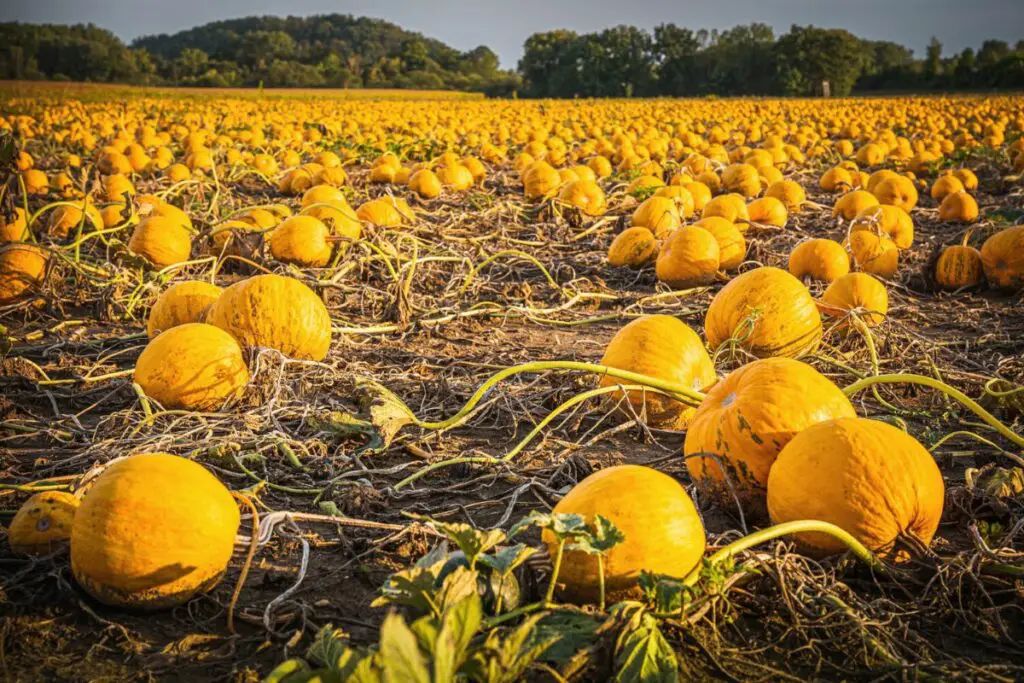
Identifying Split Pumpkins for Consumption
You don’t have to dispose of split pumpkins right away, especially if the damage is caused by physical stress without pests or secondary infections.
You can still use the pumpkin for cooking if it meets the following criteria:
- The crack is shallow and doesn’t reach the flesh.
- The split area has no bruises, rot, or mold.
- There’s no rotten smell.
- The flesh is hard, not mushy or sticky.
For safe consumption, you can follow the steps below:
- Wash the pumpkin thoroughly.
- Use a clean, sterile knife to cut through the fruit. A healthy flesh should be rich orange and hard.
- Scoop out the stringy flesh and seeds. Healthy seeds should be white.
- Remove the stringy flesh, wash the seeds, and allow them to dry for roasting.
- Slice the hard flesh into cubes and puree it. You can then use the puree to prepare your favorite pumpkin recipes.
Final Thoughts
Pumpkins, especially the giant varieties, can sometimes split on the vine if they’re allowed or forced to grow too big too quickly. Issues like overwatering and overfertilizing can increase the risk if you grow your pumpkins in an area with poor soil drainage and insufficient sunlight.
Grow your pumpkins at a moderate pace and avoid overfeeding them with water and fertilizer. Prune the smaller fruits four weeks before harvest to prevent the remaining fruits from soaking up most of the moisture and nutrients.
It’s also important to harvest your pumpkins on time to prevent issues like overmaturity and sunburn from damaging the rind.
Remember the tips shared in this article to help you grow the best-quality pumpkin fruits next season.

